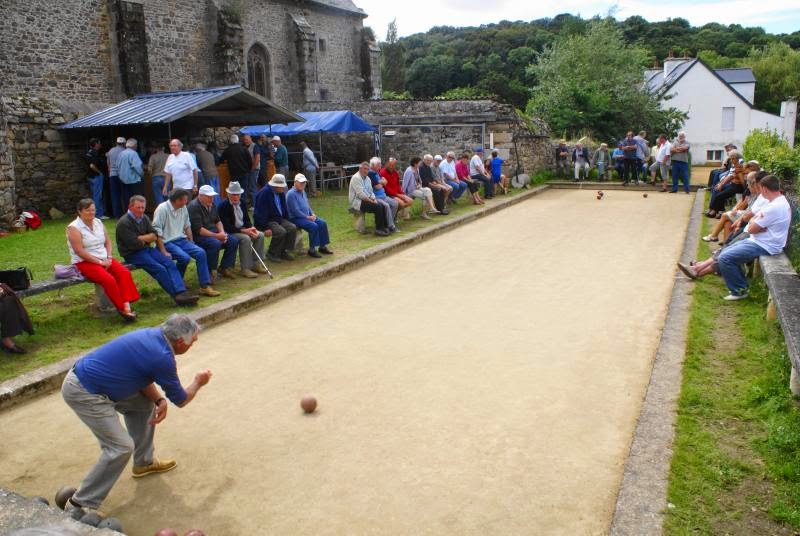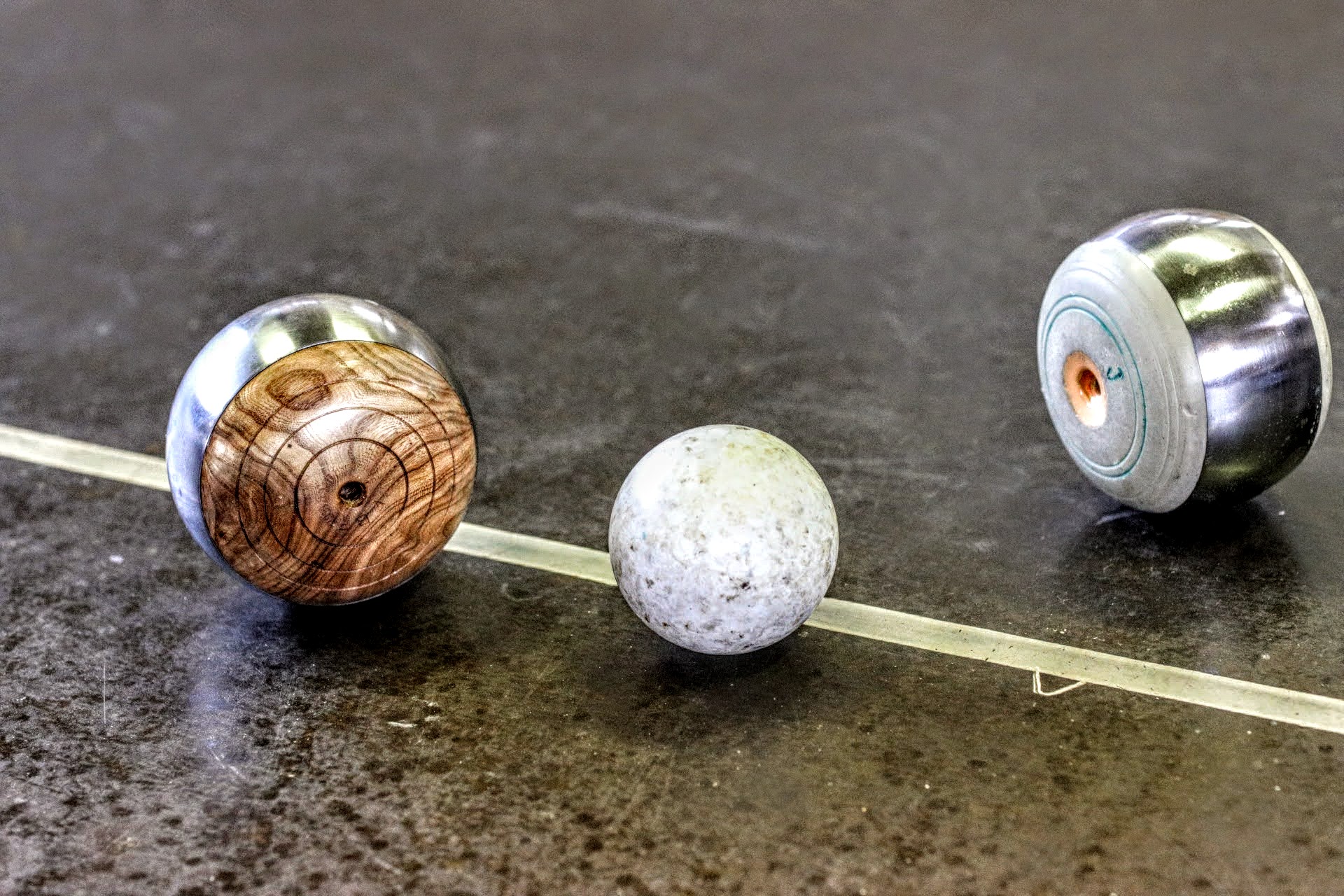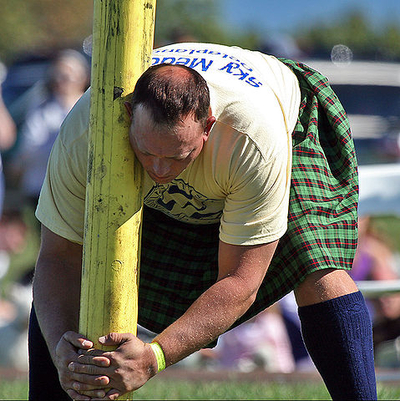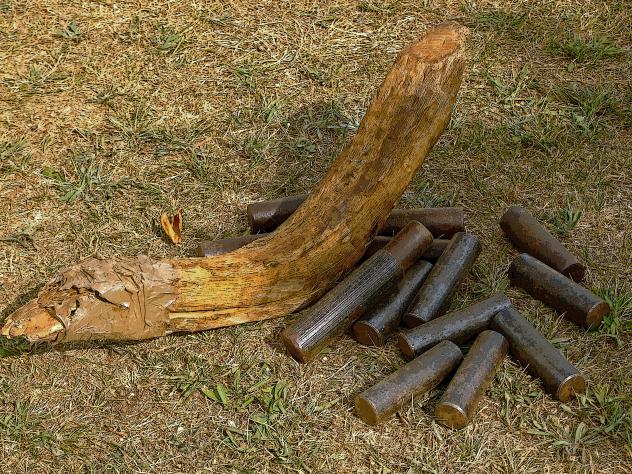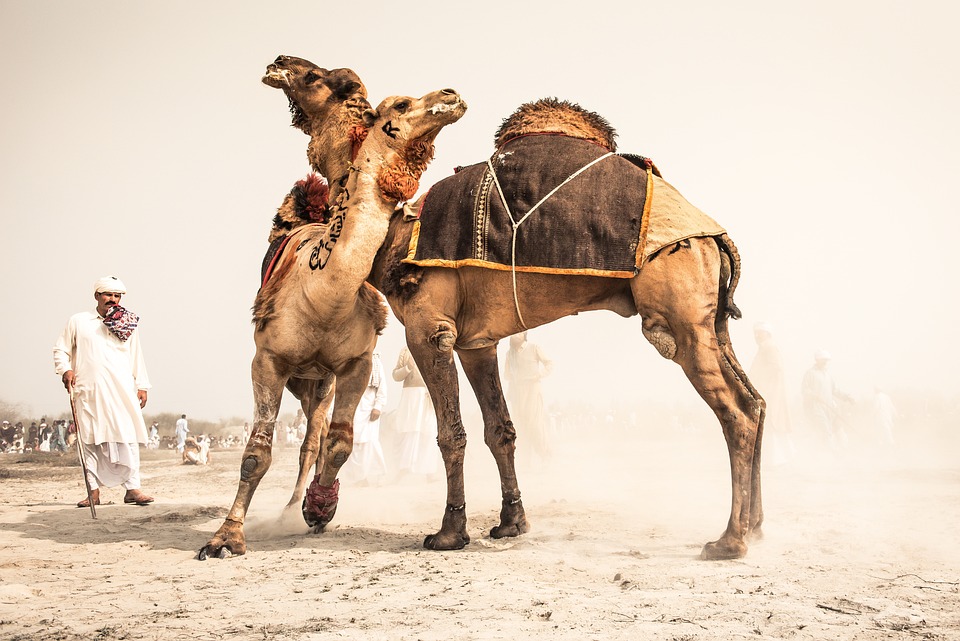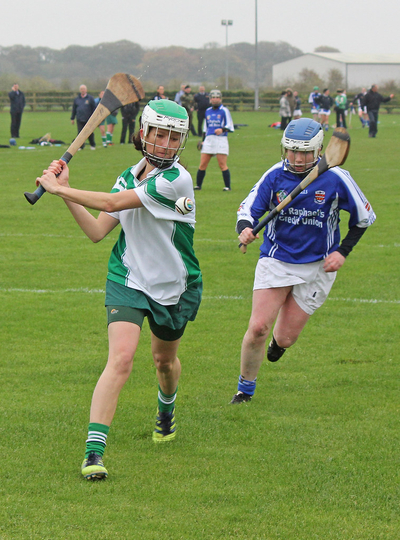- Name of sport (game): Bola Canaria
- Place of practice (continent, state, nation):
Canary Islands
- Description:
The main objective of the Canarian ball is to place the ball as close to a specific objective, which in this case is the so-called Boliche or Mingue.
To play 12 balls are used per team, which will be of the same color within the team, and thus differentiate themselves from the opponent. The material with which the balls are made is usually a paste that must be approved by the Canary Islands Federation.
The ball will have a maximum diameter of 120mm and a minimum of 90. The weight will range between 1,000 and 1,200 grams.
The development of the game consists of adding points, which will be defined based on the number of balls closest to the bowling alley.
The teams will be formed by a number of players, normally four, and each of these will have a maximum number of three balls.
For practice, a series of categories is established among the players. They will be children from 10 to 14 years old, youths from 15 to 18 years old and seniors from 18 years old.
Bowling is one of the key pieces in the game, since it is the object that serves as a reference. It will have a diameter of 35 to 45 mm. having to be metallic with a maximum weight of 50 grams and a maximum of 500 grams.
The playing field will be rectangular, at least 18 meters long and a maximum length of 25 meters.
The width of the pitch cannot be less than 3.5 meters nor greater than 6 meters.
The floor of the field of play shall be of earth, deck, sand or any similar material.
- Name of sport (game): Bolo vaqueiro
- Name in native language: El Bolo vaqueiro
- Place of practice (continent, state, nation):
Spain
- Sources of information :
Video:
- Name of sport (game): Bondetag
- Place of practice (continent, state, nation):
Sweden
- Name of sport (game): Boukatag
- Place of practice (continent, state, nation):
Sweden
- Name of sport (game): Boule Bretonne plombée
- Name in native language: Boule Bretonne plombée
- Place of practice (continent, state, nation):
Brittany, France (region of Morlaix)
- History:
The origin of the typical game of the Morlaix region is not very well known but boule being a very popular game that was played in sunken lanes, the use of an eccentric weight was surely thought to compensate for the effects of slope of the paths. In 1783, Admiral De GUICHEN (a Comte Morlaisien) is described playing bowls near the Quai de Tréguier where a playground had been set up. He played there every afternoon which seemed to mean that the playing area was covered.
The track of the leaded ball game resembles the billiard tracks of the Middle Ages which is still found in Germany and Belgium (billiards was played on the ground).
The heyday of popular games and particularly boules is at the end of the 19th century and the beginning of the 20th century. In the recent past, especially between the two wars, the game of boules has experienced tremendous development and the practice of this game took place in private alleys which were located in the shops (cafes) of each village or municipalities, even neighborhood.People gathered every Sunday to practice their favorite game and that in formal attire, suit, white shirt and tie. These parties usually took place in the afternoon, which allowed them to meet and talk about daily life, local affairs and community life. These friendly meetings are still perpetuated in many friendly on the municipal alleys.
The game of leaded boules in the Pays de MORLAIX is played mainly in North Finistère in an area stretching from Plouvorn to Locquirec and from the Ile de Batz to Botsorhel.Source: http://www.falsab.com/fr/boule_plombee_morlaix
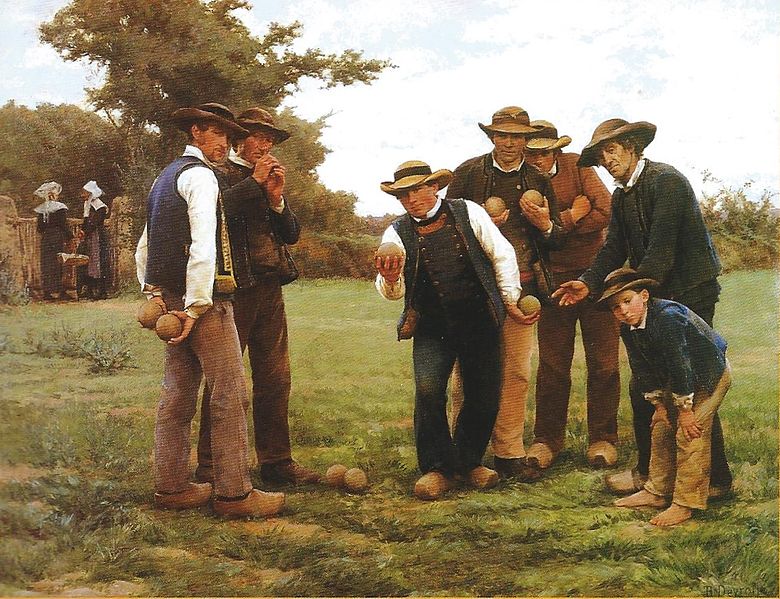
Théophile Deyrolle, Les joueurs de boules (à Beuzec-Conq, 1887) - Description:
This game can be played outdoors or in a covered room on a carpet. The games take place in twelve points, in teams of: 2 - 3 - 4 people or individually.
The game of leaded Breton boules from the country of Morlaix requires two leaded balls in hardwood or resin. They weigh between 1.8 kg and 2.3 kg and are between 12.5 and 13.5 cm in diameter. The more fragile wooden balls are hardly used any more. They are now replaced by resin balls. In order to recognize his boules on the alley, the player puts a colored point in the counter or engraves his initials. In recent years, multicolored balls have appeared.
Formerly, the leaded Morlaisian ball was entirely made by a carpenter, in guaiac wood, a rare, extremely hard and dense species, imported from South America.
The peculiarity of this leaded ball is to turn when it slows down. The ground is flat and groomed and measures approximately 20 m by 5.
This sport is played on alleys that are between sixteen and twenty meters long and between four and five meters wide. It can be outdoors or indoors (bowling alley). It is made of beaten earth covered with a layer of fine sand and is surrounded by wooden planks. Lead balls should be thrown by rolling them and not by throwing them from above to avoid damaging the fairways. Each hole in the aisle deflects the boules from their path and play becomes impossible. In some municipalities where dirt walkways do not exist or when the weather is not favorable, the game takes place on indoor carpet.
The Breton ball as it is practiced in northern Finistère in the region of Morlaix has its particularity and is undoubtedly the most unique of current Breton boules. Its main characteristic is to have five lead cylinders housed perpendicularly in the mass. The first four are arranged on the track. This tread guides the ball to allow it to go straight. But this game of skill is more subtle ... The fifth lead called the "strong" is encrusted on one side of the tread. Its role is essential and characterizes the game. It allows the ball to turn when its speed decreases. This lead unbalances the ball to the left or the right depending on the direction the player wants to get. Opposite the "strong", an unleaded cavity, called "contre fort", is made to accentuate the effect of the opposite lead.
As a general rule, if the bowler wants to send his boule to the right, he will throw it with his fort on the right but to the left. At the start of the course, the ball will move to the left, but its speed decreasing, will describe a curve to move ... to the right.
This game requires a lot of concentration, technique and strategy. The player can choose his placement to play his boule across the width of the fairway as long as one foot touches the back board.
The choice of this placement is essential because depending on it the curve obtained will be different. The measurement consists in positioning the straw between the ball and the ‘’bihen’’ to make it hold. This practice is called "bypass surgery". The straw should fit between the winning boule and the ‘’bihen’’ while it does not fit on the losing boule. In the Morlaix region, every café, both in town and in the countryside, had its path of lead balls.Source: http://www.falsab.com/fr/boule_plombee_morlaix
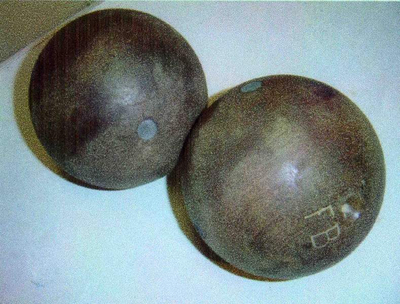
- Current status:
Currently, there are twelve structured clubs, eight of which are affiliated with the Federation. Its last can be found in Morlaix, Saint-Martin-des-Champs, Ploujean, Plougasnou, Taulé, Guiclan, Carantec, Lanmeur, Locquénolé, Locquirec, Saint-Jean-du-Doigt.
- Contacts:
La Fédération des boules plombées du Pays de Morlaix
Webside: http://www.federation-boule-plombee.fr/
Fb: https://www.facebook.com/bouleplombee/This email address is being protected from spambots. You need JavaScript enabled to view it. 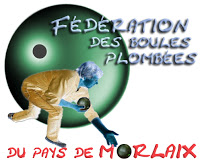
Amicale Plouganiste des Boules Plombées
https://www.facebook.com/APBP29/
Tel.: +33 6 95 70 42 66This email address is being protected from spambots. You need JavaScript enabled to view it. 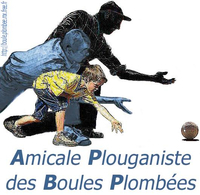
Boule Plombée Bro Gwenrann
https://www.facebook.com/bouleplombeebrogwenrann/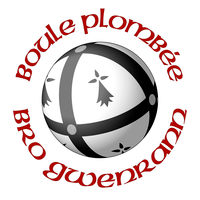
- Sources of information :
Video:
https://www.youtube.com/watch?v=jhDeZTKc4jw
https://www.youtube.com/watch?v=9672YVZg--M
https://www.dailymotion.com/video/x2tyeg
https://www.youtube.com/watch?time_continue=1&v=K9-eYesqPd8&feature=emb_logo - Gallery:
- Documents:
- Name of sport (game): Boule do fort
- Name in native language: Boule de fort
- Place of practice (continent, state, nation):
Val de Loire (neighboring departments), France
- History:
The boule de fort is a traditional game of the Pays de la Loire classified in the inventory of French intangible cultural heritage. It appeared in the Anjou region in 1660. Many legends and beliefs are running about it. The most widespread version tells that mariners of the Loire would have taken the habit of playing at the bottom of their boats. This would explain the curved shape of the runway similar to a boat hold. But, this form could also come from ball games made in the moat of the castles of the Loire. Nevertheless, all agree that the appearance of societies or ball circles dates from the early nineteenth century.
The origin of the boule de fort game is rather mysterious. There are a lot of different theories about it. Some say, the game was first brought to the Loire valley by English and Dutch merchants who played a similar game called “boulingrin” (“bowling green” or “lawn bowl” in English as a reference to grass fields) which was popular all over the Commonwealth. In some parts of Belgium and the Netherlands as well as in the North of France (around Tourcoing, Lille, …), people played “bourle” which is also similar to “boule de fort”. In fact, nobody really knows where this sport comes from, but this doesn’t keep people from playing!
- Description:
The boule de fort is a game that involves throwing balls to get as close as possible to a pig called master or small (of a size between 80 and 90 mm) in order to score points. The difficulty stems from the fact that one side of the ball is heavier (stronger) and leads them in its direction, and the edges of the runway resemble a gutter section. The balls can take more than a minute to reach their destination from where very long parts, up to three hours. A game is usually played between teams of 2 or 3 players with 2 balls each. Sometimes games are played at 1 to 1 with 3 balls per player and sometimes at 4 to 4 with 1 ball each. The winning team is the one that scored 10 points the first.
 Source: https://www.fedebouledefort.fr/la-boule-de-fort/le-jeu
Source: https://www.fedebouledefort.fr/la-boule-de-fort/le-jeu - Current status:
The “boule de fort” clubs or circles are convivial places where people meet to play and train for challenges, but also to have a chat. Maintenance fees are payed with the income of the refreshment bar.
Today, clubs are open to everybody, but it was not always like this: up to the 1970s, women were not allowed in the clubs and newcomers could only be admitted when sponsored by a club member.La Fédération de Boule de Fort created in 1907 has continued to evolve since then to become la Fédération Française de Boule de Fort.
- Contacts:
la Fédération Française de Boule de Fort
4 rue La Bruyère
49100 Angers, Pays de Loire
France
Website: https://www.fedebouledefort.fr/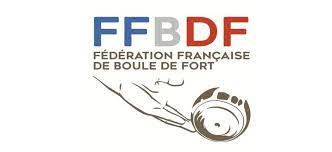
- Sources of information :
Literature:
Marc Leclerc, Notre boule Angevine, Éditions de l'Ouest, 1933
Émile Joulain, La boule de fort, Paquereau Technographis, 1976
Denis Libeau et Émile Joulain, La boule de fort, Éditions Herault, 1986
Joël Guibert, Joueurs de boules en pays nantais, L'Harmattan, 1994
André-Hubert Hérault et Denis Libeau, Voyage au pays de la boule de fort, Éditions Hérault, 1999
Max Ménard, Histoire de la boule de fort: histoire de la société "les Artisans" 1829-1998, M. Ménard (Impr. Copie Boutique), 1999
Jacques Sigot, Les dossiers de la mémoire, La boule de fort, Éditions C.M.D., 2000
André Hubert Hérault et Denis Libeau, Voyage au pays de la boule de fort, Hérault, 1999
Jean-Luc Marais, Histoire d'une sociabilité du 18è siècle à nos jours, Anjou, Maine, Touraine; Éditeur: Jean-Luc Marais Et Éditions Ivan Davy, 1986Articles:
https://www.anjou-tourisme.com/fr/voir-faire/activites/la-boule-de-fort-en-anjou
https://www.ancienne-ecole.com/en/discoveries/the-boule-de-fort-game/Video:
https://www.youtube.com/watch?v=OV-zRgTx8cA
https://www.youtube.com/watch?v=h9OLHWn6UEA
https://www.youtube.com/watch?v=I7aEyldWlv4Photos credits: Guillaume Lanouhe, Association Brev’Art
Lieux : Boule de Fort, Le Soleil Levant, Tours - France - Gallery:
- Documents:
- Name of sport (game): Caber Toss
- Place of practice (continent, state, nation):
Scotland
- Description:
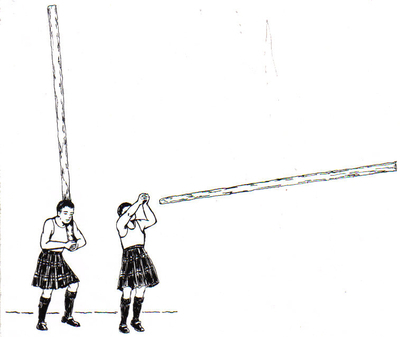
- Sources of information :
Video:
https://www.youtube.com/watch?v=fhybD2V30Q4&feature=emb_logo
https://www.youtube.com/watch?v=xb0FU8rSisU
https://www.youtube.com/watch?v=Pj6_JAn5teA - Gallery:
- Name of sport (game): Calva
- Name in native language: Calva
- Place of practice (continent, state, nation):
Spain, mainly in Castile, Salamanca, Zamora, and Biscay, although also in Madrid, Barcelona, Plasencia and Navarre. Also practiced in the province of León, as in all the ancient Kingdom of León (León, Zamora, Salamanca...), the lands of the shepherds of transhumance.
- History:
Calva is a traditional sport practiced in certain parts of Spain. It has roots going back to pre-Roman times, being developed by the Celtiberians who lived in the modern-day provinces of Ávila, Salamanca, and Zamora. It was a game for shepherds, who threw stones at bull's horns to entertain themselves. With the passing of time, the game was modified: a piece of wood (the calva) came to be substituted for the horn, and the stone was replaced with a cylinder of iron or steel (the marro). The name of calva was derived from the field in which the game came to be played, which was free of obstacles and rocks.
- Sources of information :
Video:
https://www.youtube.com/watch?v=wISnAVwgfK4
https://www.youtube.com/watch?v=Ok8r8aBJsCk&fbclid=IwAR0pPOqZpsTrYxNnMhadFmc5vKNnTnnaLBSmh30ble4jGLHHacVtceO4y4U - Gallery:
- Name of sport (game): Camel wrestling
- Place of practice (continent, state, nation):
Turkey (also in other countries such as Pakistan)
- History:
It is said that the first camel wrestling competition was held in the village of Hidirbeyli in Aydin’s Incirliova township about two centuries ago. However, A. Münis Armağan gives a different account in his book Batı Anadolu Tarihinde Ilginç Olaylar (Interesting Incidents in Western Anatolian History), in the chapter on the “End of the Camels.” Armağan writes that camel wrestling was done in the time of Mahmut II, in Tire and its surroundings.
Although the origin of camel wrestling cannot be placed exactly, it is believed that it started during nomadic times. People interested in camel wrestling or camel owners say that the nomads used to have their camels wrestle as part of the competition between caravan owners.
Today, camel wrestling is popular mostly in Aydin. It is also seen in the cities of İzmir, Manisa, Muğla and Denizli in the Aegean region, Balıkesir and Çanakkale in the Marmara region and Burdur, and İsparta and Antalya in the Mediterranean region. - Description:
Although camel wrestling has certain rules, these rules may vary from area to area. Unlike other sports, camel wrestling does not require a special field or spectators. Most of the time, organizations active in areas such as; education, culture, health, sports or social welfare holds camel wrestling competitions as fundraisers. In some areas, municipalities also help to organize the event so as to bring order and discipline to the competitions.
The proceeds earned from camel wrestling, after costs are deducted, are used for certain purposes. Neither pari-mutuel arrangements nor betting are allowed. Only male camels can wrestle in these contests, and then only those born to female camels with a single hump (dromedary or “yoz” camels) or those with double humps (Bactrian or “buhur” camels). As a class, these wrestling males are called “tülü” camels. These camels are bred especially for wrestling, which means that the ancestors of these wrestling camels were wrestlers themselves.
These camels are bred with a great deal of care and are trained for wrestling. The contests are held in the winter months of December, January, February and March when the tülüs are in heat. Every wrestling camel must have a name. Sometimes the camel’s owner gives it a name, and sometimes the spectators find a name for the camel inspired by how it behaves during wrestling matches. Some camels are named after popular characters from TV shows, such as American detective Columbo and Şahintepesi. Other examples of camel names are Dozer, Gezer, Sarizeybek, Yörükali, Almanyali, Ceylan, Felek, Ali Tülü, Talanci, Karka Kartali, Suat, Zümrüt, Menderes, Firat, Takmakol, Şoför, Civan, Karamurat, and Yarimdünya.
The name of the competing camel is written on a piece of embroidered cloth called a peş hung behind the saddle, which is called the “havut.” Beneath the camel’s name is written the word Maşallah (May God protect him).
In the wee hours of the meeting, crowds of people start flocking to the wrestling field while the camel owners try to find a good spot in the fields where their camels can face each other, those who want to watch the matches grab good place for themselves and their families. They cook meat on a barbecue spit. By about 9 or 10 o’clock, the camel wrestling fans have filled the field. Street sellers set up their stands and tables around the field where they offer a wide variety of food, drinks and souvenirs, while drummers and zurna players play traditional tunes. Inspired by the music, some people dance the traditional zeybek dance.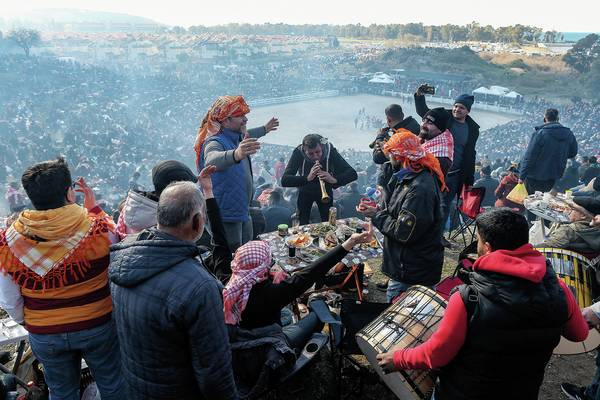
During all this hullabaloo, loudspeakers blare the names of the camels set to compete, thus signalling the beginning of the contests proper. Now the activity around the field moves to focus inside the field of competition. Camel owners bring their camels into the wrestling area. First the camels walk a lap around the field, after which they start wrestling usually between 9 and 10 o’clock.
The cazgir; the person who announces wrestlers or the wrestling camels – calls out the camels’ names. The cazgır reads poems praising each camel, adding colour to the contest. This cazgır, just as in two-legged wrestling contests, is the most important and colourful person in the competition. He treats the camel wrestling match just like a sports announcer acting as commentator to a soccer match.
Within the wrestling organization, there is a refereeing council formed by a chief referee, middle referee and table referee, as well as an urgancı (a person who deals with ropes), people responsible for tying camels’ mouths, and a person who checks the camels’ mouths after they are tied.Camel wrestling is held in four categories, namely Foot, Middle, Under the Head and Head.
A camel can win in any of three ways:- by making the other camel retreat,
- by making the other camel scream,
- or by making the other camel fall.
In the first road to victory, one camel sends his rival into retreat with just his fearsome appearance.
In the second, one camel overpowers the other so much that he makes him scream.
In the third, one camel cunningly manoeuvres the other to make him fall down. The winning camel goes and sits on his vanquished competitor.
Another way victory can be secured is when the camel’s owner takes his fighter out of the contest in order to prevent him from being hurt. The camel owner throws a rope on the ground indicating that he is withdrawing from the contest. The other camel is declared the winner. And sometimes the game ends in a tie.
Below are some terms used to refer to tricks and manoeuvres employed during wrestling: Bağ, Çengel, Çatal, Makas, Kol Atmasi, Muşat Çengel, Tam Bağ, Yarim Bağ, Düz Çengel, Tekçi, and Kol Kaldirma.
The contest’s organizers try to pit camels who excel at different tricks to make the matches more exiting. Every camel wrestles with a tülü from his own class. Camels that wrestle from the right are called “rightist,” camels that wrestle from the left are called “leftist,” camels that trip the other by using foot tricks are called “çengelci,” camels that take their rival’s head under their chest and then try to sit are called “bağci,” and camels which push their rivals to make them beat a retreat are called “tekçi.”
The winning camel stands with his four feet together and greets the audience in a proud, boastful manner. He accepts a rug as his award and then exits the wrestling field. The camel which loses, on the other hand, looks embarrassed and keeps quiet.
A camel wrestles just once per day and each wrestling match lasts for 10 or 15 minutes. These rules exist to prevent the camels from being too badly hurt or even dying as well as to protect their well-being.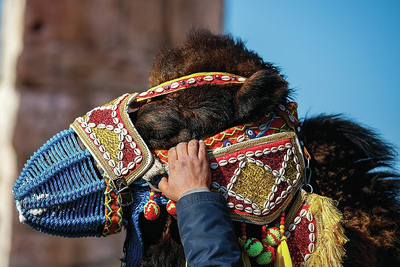
- Current status:
In Turkey, camel wrestling is one of the country's oldest traditions and is an event that is gaining in popularity with tourists every year. The event not only consists of the camel fight, but the celebration brings together thousands of people in a festive atmosphere to eat and drink typical products. This factor is making this activity a popular option for certain tourists, attracted by the folklore of the celebration.
However, these fights are strongly criticized by different animal defense organizations that report not only their cruelty, but also their illegal character within the Turkish Animal Protection Laws and punished by their Penal Code.
Since 1982, the Selcuk Efes Camel Wrestling Festival has been one of the best known festivals, attended by 20,000 people and a growing number of tourists. More than 140 camels are used in the fights, which last approximately five minutes. Even so, there are dozens of such fights which, understood as a sport, are organized as a league.
Today, there is a "Camel Wrestling League" organized between November and March every year in the Aegean region and the Mediterranean region, in western and southern Anatolia. Below is a list of towns and villages where these matches are usually held:Karpuzlu, Gullubahce
Atca, Furunlu village in Bayindir town, Golmarmara, Oren, Yenikoy
Bozyurt, Gokcebeyli, Gulluk ve Kocarli
Didim, Harmandali, Kosk
Ayvalik, Buharkent, Cine
Dikili, Ezine
Bodrum, Incirliova
Bayramic, Germencik, Menemen, Saraykoy
Canakkale, Selcuk, Yatagan
Kumluca, Selimiye, Sultanhisar, Tire
Bagarasi, Bayir, Burhaniye, Demre, Pinarbasi
Biga, Odemis, Soke, Yenipazar
Bergama, Edremit, Kuyucak, Milas, Umurbey
Cine, Havran, Nazilli
Denizli, Bozdogan, Can, Salihli, Poyracik, Torbali
Altinova, Ayvacik, Bayrakli, Kosk
Aydin center, Buldan, Cal, Odemis
Gonen, Gokkaya, Ortaklar
Karapinar, Yazidere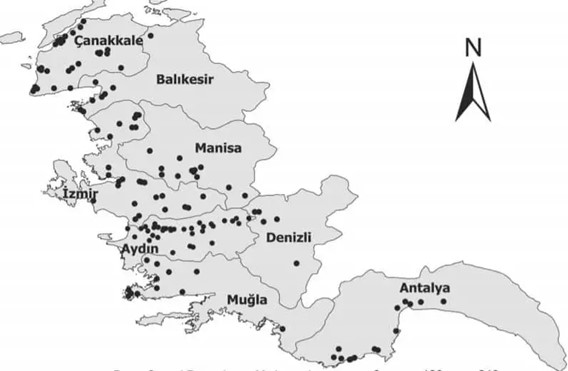
Source: https://visitlocalturkey.com/camel-wrestling-festival/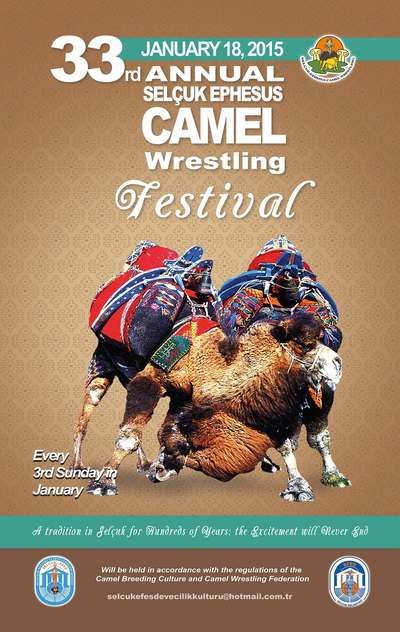
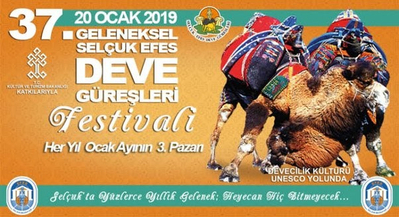
- Importance (for practitioners, communities etc.):
One day before the wrestling contest, the camels are decked out in a manner prescribed by tradition. They are then walked through the streets accompanied by music played on the drums and zurna. This is a spectacle which everyone should see at least once. When you come into the town before a tournament, you can hear the zeybek music played with the drums and zurna and the sounds of bells dangling from the camels. The dressed-up camels are worth seeing. You could never tire of watching them. The entire town takes on a carnival atmosphere. Large crowds gather in front of the kahvehanes, the tea houses where men (but not women) go to play cards or backgammon. Camel wrestling fans get involved in boisterous discussions about the camels set to compete.
The camel owners are easy to spot due to their distinctive dress: cornered caps, traditional scarves around the neck, jackets, special trousers and accordion-like boots. Some camel wrestling enthusiasts who don’t actually own camels also dress in similar outfits. Some fans sit around TV sets to watch earlier wrestling contests which were videotaped. On the evening before the camel wresting contests, a “Hali Gecesi” (Rug Night) occasion is held with the attendance of camel owners and other guests. This is the sort of festivity where people meet new friends and old acquaintances strengthen their bonds of friendship. They eat, drink, sing songs native to their particular region, dance, entertain their guests and also sell rugs at an auction. This “Hali Gecesi” is definitely organized on the night before the wrestling. People prepare food beforehand and they eagerly await the wrestling competitions the next day.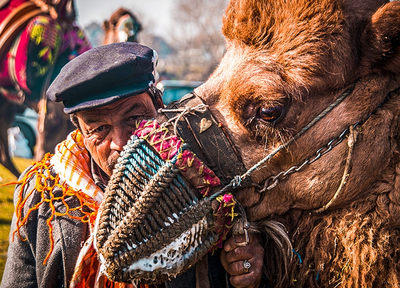
- Sources of information :
Articles:
https://turismo-responsable.com/en/s109-camel-fighting
https://www.euronews.com/culture/2022/01/19/international-camel-wrestling-festival-kicks-off-in-turkey-amid-animal-cruelty-controversy
https://www.nytimes.com/2021/06/28/travel/turkey-camel-wrestling.html
https://www.dailysabah.com/turkey/camel-wrestling-festival-a-legacy-of-turkeys-yoruk-culture/news
https://selcukephesus.com/events/camel-wrestling-festival/
https://eskapas.com/camel-wrestling-festival-in-turkey/
https://turkiyeexplore.com/camel-wrestling-festival-turkey-explore/
https://turkishtravelblog.com/camel-wrestling-turkey/
https://eurasianet.org/turkey-tradition-of-camel-wrestling-making-a-comebackVideos:
https://www.rferl.org/a/pakistan-camel-wrestling/29810839.html
https://www.youtube.com/watch?v=KxzCh-SB7a4&t=3s
https://www.youtube.com/watch?v=WLSDKh_LVHk
https://www.youtube.com/watch?v=QM5hXrV_4ekThe information contained in the article comes from the following sources:
https://turismo-responsable.com/en/s109-camel-fighting
https://www.ktb.gov.tr/EN-100048/camel-wrestling.html
https://www.allaboutturkey.com/camel.htmlSource of photos used in this article and gallery:
https://pixabay.com/photos/camel-fight-camel-fight-3903550/
https://www.dailysabah.com/turkey/camel-wrestling-festival-a-legacy-of-turkeys-yoruk-culture/news
https://www.aa.com.tr/en/vg/video-gallery/camel-wrestling-festival-in-turkeys-izmir
https://yabangee.com/camel-wrestling/
https://turkishtravelblog.com/camel-wrestling-turkey/
https://www.nwaonline.com/news/2022/jan/23/bejeweled-camels-wrestle-for-victory-in-turkey/
https://www.dailysabah.com/expat-corner/2019/11/07/camel-wrestling-season-kicks-off-in-turkey
https://artofwayfaring.com/destinations/the-selcuk-camel-wrestling-festival/
https://antalya.com.tr/en/festivals/Traditional-Kumluca-Camel-Wrestling - Gallery:
- Documents:
 Orhan_Yilmaz_History_of_Camel_Wrestling_in_Turkey.pdf
Orhan_Yilmaz_History_of_Camel_Wrestling_in_Turkey.pdf Orhan_Yilmaz_Mehmet_Ertugrul_Camel_Wrestling_Culture_in_Turkey.pdf
Orhan_Yilmaz_Mehmet_Ertugrul_Camel_Wrestling_Culture_in_Turkey.pdf
- Name of sport (game): Camogie
- Place of practice (continent, state, nation):
Ireland, Australia
- Contacts:
The Camogie Association
3rd Floor,
Westward House,
Russell Street,
Dublin 1
D01 F300
Phone: 01 865 8651
Webside: https://camogie.ie/
Facebook Facebook.com/OfficialCamogieAssociation
Twitter: @officialcamogie
Instagram: @officialcamogie
YouTube: @officialcamogie
- Sources of information :
Articles:
https://gaelicgameseurope.com/games/hurling-camogie/
https://www.libertyinsurance.ie/blog/everything-you-wanted-to-know-about-camogie
http://scoilsportg.ie/gallery/category/6-album-6Video:
https://www.youtube.com/watch?v=70ePVvm1tU4
https://www.youtube.com/watch?v=rZ3iA0GUSec
https://www.youtube.com/watch?v=Iv_xXmXzQt4 - Gallery:
- Documents:
- Name of sport (game): Catch-Hold
- Name in native language: Cath-Hold
- Place of practice (continent, state, nation):
England
- History:
Historically, the greatest wrestlers of England came out of the two “most wrestling regions” of the country, the West Country (Devonshire, Somerset, Dorset and Cornwall) and the North Country (Cumberland, Westmorland, Northumberland, Durham, Lancashire and Yorkshire). Residents of those regions promoted two different wrestling styles. The West Country style which was commonly known as the Cornish-Devon Wrestling was a standing catch-hold of the jackets above the waist, tripping and hooking legs allowed, back fall decided the winner, 3 foils or “go downs” substituted 1 back fall. According to the English wrestling tradition back fall was defined as a combination of shoulders and hips touching the ground simultaneously. The North Country Wrestling which was known as the Cumberland and Westmorland Back-Hold was a fixed hold style, tripping and hooking legs allowed, first down to lose. Representatives of those two wrestling styles usually didn’t compete against each other. But sometimes they challenged one another without being specific regarding the style of wrestling. In that case wrestlers were allowed to “catch any holds of their adversary’s body (not just clothes like in Cornish-Devon) above the waist, tripping and hooking legs being allowed”; sometimes a back fall decided the winner. But since all falls were “flying falls” and many of them were “disputed falls” more often the condition of “3 go downs” decided the match. This style was popular all over the country and was known as the Catch-Hold or a Peasants’ Wrestling. This style for centuries was practiced mostly by the farmers during the revels weeks and other folk and religious festivals. It was themost commonly seen mode of wrestling on the “village greens”everywhere in England.
The “Chap-books of the Eighteenth Century” by John Ashton (published in 1882) features a story based on a folk tale about a “poor labourer in the reign of William The Conqueror called Tom Hickathrift of the Isle of Ely in Cambridgeshire.” Tom Hickathrift was a legendary character of East Anglian English folklore famous for “having more natural strength than twenty common men.” This story provides a good account of the traditional English Catch-Hold wrestling. “…he (Tom) would jump, run, and take delight in young company, and go to fairs and meetings, to see sports and diversions. One day going to the wake, where the young men were met, some went to wrestling, and some to cudgels, some to throwing the hammer and the like… After this Tom joined the wrestlers; and though he had no more skill than an ass, yet by main strength he flung all he grappled with; if once he laid hold, they were gone; some he threw over his head, and others he laid down gently. He did not attempt to lock or strike at their heels, but threw them down two or three yards from him, and sometimes on their heads, ready to break their necks. So that at last none durst enter the ring to wrestle with him; for they took him to be some devil among them.” Interestingly, Tom’s proficiency in strength and his speed allowed him to lay (catch) hold, lift and throw all his opponents with great ease. The choice of this strategy prevailed over other popular wrestling techniques, such as “locking and striking” (hooking legs and tripping). This narrative shows the evolution of English folk wrestling tactics, and how taking the advantageous and fast hold became the dominant wrestling technique.
Famous Egerton Genesis (3rd quarter of the XIVcentury) contains beautiful visualization of such English "Peasants’Wrestling." On the sketch we see three pairs of wrestlers struggling for thepalm. The applied catch-holds techniques are shin kicking at Arm's Length,Close Struggle’s hooking legs and “playing with the hip” (Headlock intoCross-Buttock) at Side Holds Hugging. Notably, the wrestling style towhich greatest English Renaissance author William Shakespeare refers toin his famous "As You Like It" was also a Catch-Hold wrestling.
Traditional English Catch-hold was a product of evolution of the folk and professional English wrestling styles which predated it. In the pre-Renaissance England there were 3 such styles of wrestling. There were no jackets or garments of any kind worn by pro wrestlers of that era, instead the wrestlers were wearing the “wrestling tools” which they used for “taking holds by” during matches. One of those “tools” was a “wrestling collar” and another was a “wrestling belt.” Besides wearing those special “tools” wrestlers usually had only a loin clothes (or shorts) on them, so they basically they were half-nude, often no shoes were worn. The Medieval English wrestling styles were:
1) The Collar Wrestling (wrastelynge by the coler). The “Collar”' was a simple rope or a shawl tied either around the neck or around the torso (over one shoulder and under the other). It was a catch-hold wrestling style, one hand to the collar and with another hand wrestlers usually would grab the wrist or the elbow of their opponent. In this style wrestlers had each other on a distance, at arms’ length, so all their efforts were focused on the footwork. Tripping, hooking/crooking opponent's leg with your own leg, and yes of course kicking, or striking was important part of it. Only “fair” kicking below the knee was allowed. The best collar wrestlers of England came from the Norfolk County. Notably, the crest of the local noble family of Norman origin De Gournay (modern spelling Gurney) of West Barsham and Keswick was a wrestling collar in an enameled ring.
2) The Belt Wrestling (wrastelynge by holdster). The “Belt” was usually also a rope or a stout leather belt girdled around the waist. It was also a catch-hold style, one hand to the belt and with another hand wrestlers usually would grasp the wrist or elbow of their opponent. In this style wrestlers would try to get in a close quarters, and the cross-buttock would be the main way of throwing, they called it a hip-lift techniques, tripping and hooking also were important at that style. In this style there was less kicking since it was not as productive as when you have your man at arms’ length.
3) The Hug (hugg wrastelynge). In this style both men equally grabbed each other “above and under the shoulder” and from that hold (fixed hold wrestling) were supposed to give a fall. The only legit methods of throwing were: tugging, swaying and lifting. Neither use of legs or feet for throwing nor any other wrestling technique was allowed. The physical strength was a decisive factor for winning those contests.
Both the “collar” and “belt” wrestling styles were of Norman origin and the “hug” was of Norse or Scandinavian (North Germanic) heritage. Grabbing “tools” with both hands was allowed. In English folk and pro wrestling matches the noble art of tripping was a number one skill. Back falls governed wrestling contests very rare, since from a standing position (it was a Standing Wrestling) to achieve a back fall is pretty hard (depending on the definition of the back fall of course), and no one needed to waste time on further argumentation whether there was or wasn't a fall (aka disputed falls). Back fall had different definitions (various combinations of shoulders, hips and heels) but perfect back fall was a complete flat horizontal position – perfectly aligned neck, shoulders, hips, buttocks, heels striking the ground at the same time. Though most of the wrestling matches were “3 go downs” to lose meaning that it was enough to take opponent down on any part of his body (including knees, or hands), basically it was enough to cause any kind of fall by a simple take-down.
As it was previously mentioned any holds below the waist were strictly prohibited, yet the catch-holds of the legs and feet were known in English folk wrestling but solely and only as a reaction on the unfair kicking, i.e. kicking of the knee or kicking above the knee. The great depictions of these kind of holds are present in the form of Medieval misericords’ wood carvings such as those in the Abbey of St Mary the Virgin, Tewkesbury, Gloucestershire (XIV century) and in St George’s Chapel, Windsor Castle (XV century).
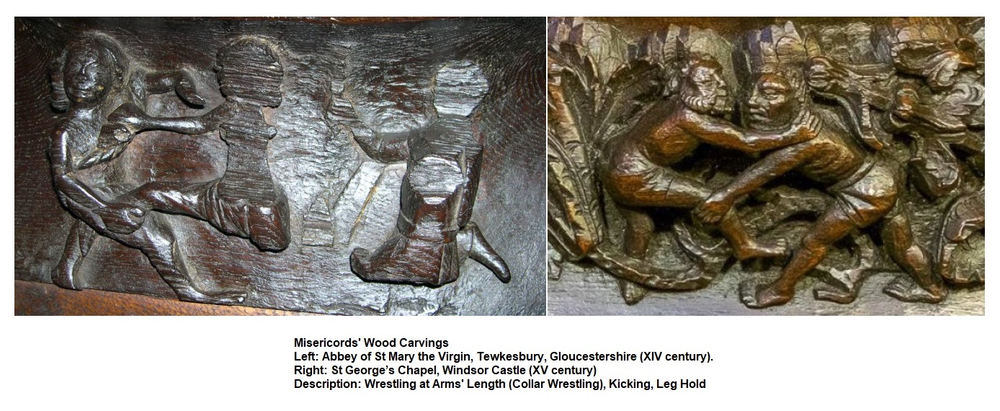
The pro wrestlers of that era were entertaining crowds during the religious or folk festivals which were held downtown, usually on the erected wooden stage, or they would go and perform on the special occasions at the castles which belonged to the local nobility. It was a paid job. In England unlike in many other European countries profession of wrestling entertainer was well established during the Middle Ages. Usually it was a travelling troupe of performers (just like acrobats, or artists) with a “manager” (veteran pro wrestler) who was trying to book his men making sure that they always have a job. The wrestlers just like other professionals (craftsmen) of that era had their own guilds (unions).
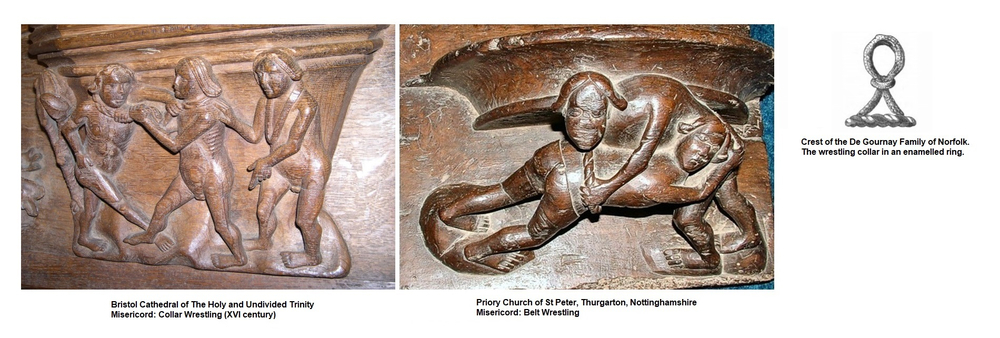
Nottinghamshire's Sir Thomas Parkyns (1662-1741), who was known as the “Wrestling Baronet” of Bunny and master of self-defense Zachary Wylde of Yorkshire both promoted Catch-Hold wrestling in the early 1700s. Parkyns "taketh what he pleaseth of him" and Wylde suggests to "take hold wherever he pleases" even including the dangerous full-nelson hold. In both cases only holds taken above the waist were considered fair.
Parkyns became famous all around the country as an author of wrestling manuals. These include, “Inn Play or Cornish Hugg Wrestler” as well as a set of “General Rules of English Wrestling,” the fullest edition of which was published in 1727. His wrestling style was the Catch-Hold, in which an initial hold doesn't exist; neither does any applied hold needed to be maintained during the match. Holds were not restricted to any sort of garments (as in Cornish/Devon) but also could be applied directly to the parts of the person’s body above the waist (neck, arms, and torso). The fair back fall was counted when two joints simultaneously hit the ground, and 3 foils (if either of two wrestlers fell upon any part of the body) were a substitute for one fair back fall. All matches were 3 out of 5 fair back falls. The wrestler would wear a waistcoat and shirt. The definition of “two joints” differed from place to place. Generally it stood for the combination of shoulder and hip on the opposite side.
Parkyns was a founder of the first annually held professional wrestling championship tournament in Bunny, Nottinghamshire. This championship existed for many years after his death and the last such tourney was held in 1809. Also it was Parkyns who in the 1700s established a basic pro wrestling promotion. At his place, he had several men whom he employed for the purpose of doing wrestling exhibitions (matches) for his friends and himself for entertainment.
For centuries there were always two champions of England those of the West and of the North. One of the famous attempts to get in the ring both champions happened in 1817. About three miles from Pinner in London, West and North finally clashed for the Championship of England. The match was for 10 guineas (gold coin worth 21 shillings) a-side. A Somersetshire man named Sam Harber wrestled Isaac Nicholson of Thirsk (North Yorkshire). Both men weighed 13st. It was a dramatic struggle that lasted 12 minutes. Westerner won by giving his opponent a “sweeping cross-buttock.” The news reports weren't specific regarding the style used in that particular contest. But it’s obvious that it was Catch-Hold since it was a one fall match and Catch-Hold was the only existing compromised style. As it was said before back then wrestlers usually competed only in their own style and there was no competitions open to the representatives
of both styles. Often Catch-Hold was called the as the “wrestling according to the London Prize Ring Rules”, which was a standing catchhold of the body above the waist, tripping and hooking legs allowed, back fall decided the victor, sometimes 3 foils substituted 1 back fall. This style was easy to learn and it didn't require any “specific knowledge”, unlike the Cumberland Back-hold (fixed hold style) or Cornish/Devon style (jacket holds only). In 1851, there was an attempt to make a “match of the century” between the two best wrestlers of their time in England. The Cumberland and Westmorland Back-hold Champion Robert Atkinson was supposed to wrestle against the Champion of Cornish/Devon Ring, Thomas Gundry. The conditions were supposed to be 2 falls in Back-hold, 2 falls in Cornish/Devon, and the odd fall in Catch-as-catch-can (more likely according to the London Prize Ring Rules). Unfortunately this match never happened.The Astley Championship Belt.
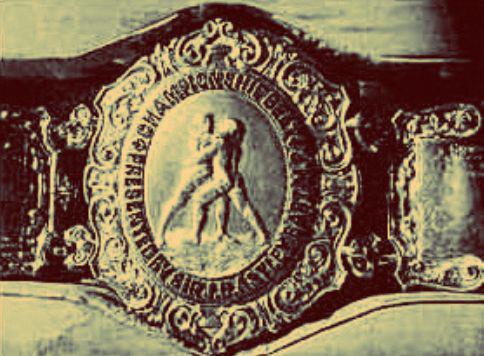 In the early 1870s the “new style of wrestling” was introduced among the London amateurs, it was called the Catch-Hold. This style became extremely popular in metropolis especially after the brilliant performances of French pro wrestlers in England. Graeco-Roman style which was advertised as the French national wrestling style impressed local sporting circles a lot. And English reply to that was the “invention” of Catch-Hold, which was designed to represent the English national wrestling traditions. That style was “invented” in London by famous bone setter Prof. J.Atkinson of 12A Park Lane in conjunction with Mr. Moses Rigg. In the early 1870s annual Catch Hold amateur tournaments along with boxing (under the patronage of Marquise Queensbury) and bicyclist championships were held at Lillie Bridge, London. Organizer of those championships was J.G. Chambers of Amateur Athletic Club (AAC) a London based amateur sports organization. First champion in 1871 was Walter Armstrong the wrestler who in 1890 wrote the famous book on wrestling called “Wrestling (Styles and Systems).” Despite the Catch-Hold wrestling being a “new invention”, it has to be acknowledged that in fact this style of wrestling can be considered the most historical English wrestling style since it basically was the old folk English wrestling style known as the Peasants’ Wrestling.Before the invention of Catch-Hold there was no such a thing as a unified English Pro Wrestling Championship. Instead there were championships of the West Country and North Country rings. During the Golden Era of Lancashire Catch-as-catch-can (1860s) the Lancashire Wrestling Ring was established as a third pro wrestling ring of England. Historically, it was acceptable to have multiple champions of England in different styles. In 1873 took place the greatest pro wrestling gathering in English history, it was the Catch-Hold Easter Tournament which was held at Lillie Bridge, London. It was the first time in history of English wrestling when representatives of all schools participated. Both Northerners and Western men were pleased with the conditions of the “new” style. Westerners were happy that it was a catch-hold style. Northern men were pleased that first down to lose condition signified victory. Both parties were satisfied that tripping and hooking legs were allowed, but the leg holds and ground wrestling, the main features of Lancashire catch were strictly prohibited. Northerners, represented by many great pro wrestlers including their long time champion Richard Wright and a rising star champion George Steadman, were expecting an easy victory (simply because they outweighed all West Country men), but it was a Lancashire man who became entitled to honors of the first unified championship of English Wrestling Ring. William Snape, aka “Dipper”, a blacksmith from Bolton, Lancashire who was known as the “Lancashire Giant” (he was 6ft2in tall and 18st weight) outwrestled them all. Organizers were trying to make that championship for professionals annual, but their initiative failed, no one would want to compete against the “Lancashire Powerhouse” Snape who soon retired from wrestling undefeated, never being able to find a worthy opponent for himself at either London Catch-Hold or at his native Lancashire Catch-as-catch-can.
In the early 1870s the “new style of wrestling” was introduced among the London amateurs, it was called the Catch-Hold. This style became extremely popular in metropolis especially after the brilliant performances of French pro wrestlers in England. Graeco-Roman style which was advertised as the French national wrestling style impressed local sporting circles a lot. And English reply to that was the “invention” of Catch-Hold, which was designed to represent the English national wrestling traditions. That style was “invented” in London by famous bone setter Prof. J.Atkinson of 12A Park Lane in conjunction with Mr. Moses Rigg. In the early 1870s annual Catch Hold amateur tournaments along with boxing (under the patronage of Marquise Queensbury) and bicyclist championships were held at Lillie Bridge, London. Organizer of those championships was J.G. Chambers of Amateur Athletic Club (AAC) a London based amateur sports organization. First champion in 1871 was Walter Armstrong the wrestler who in 1890 wrote the famous book on wrestling called “Wrestling (Styles and Systems).” Despite the Catch-Hold wrestling being a “new invention”, it has to be acknowledged that in fact this style of wrestling can be considered the most historical English wrestling style since it basically was the old folk English wrestling style known as the Peasants’ Wrestling.Before the invention of Catch-Hold there was no such a thing as a unified English Pro Wrestling Championship. Instead there were championships of the West Country and North Country rings. During the Golden Era of Lancashire Catch-as-catch-can (1860s) the Lancashire Wrestling Ring was established as a third pro wrestling ring of England. Historically, it was acceptable to have multiple champions of England in different styles. In 1873 took place the greatest pro wrestling gathering in English history, it was the Catch-Hold Easter Tournament which was held at Lillie Bridge, London. It was the first time in history of English wrestling when representatives of all schools participated. Both Northerners and Western men were pleased with the conditions of the “new” style. Westerners were happy that it was a catch-hold style. Northern men were pleased that first down to lose condition signified victory. Both parties were satisfied that tripping and hooking legs were allowed, but the leg holds and ground wrestling, the main features of Lancashire catch were strictly prohibited. Northerners, represented by many great pro wrestlers including their long time champion Richard Wright and a rising star champion George Steadman, were expecting an easy victory (simply because they outweighed all West Country men), but it was a Lancashire man who became entitled to honors of the first unified championship of English Wrestling Ring. William Snape, aka “Dipper”, a blacksmith from Bolton, Lancashire who was known as the “Lancashire Giant” (he was 6ft2in tall and 18st weight) outwrestled them all. Organizers were trying to make that championship for professionals annual, but their initiative failed, no one would want to compete against the “Lancashire Powerhouse” Snape who soon retired from wrestling undefeated, never being able to find a worthy opponent for himself at either London Catch-Hold or at his native Lancashire Catch-as-catch-can.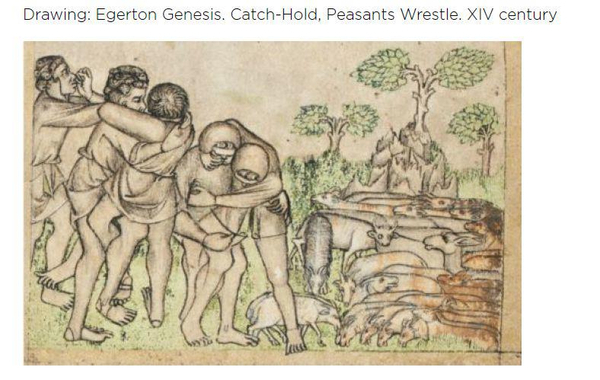
- Description:
The London Catch-Hold of the 1870s-80s was a standing catch-as-catchcan in which only holds of the body above the waist were considered legal. Of course the essence of English wrestling, the use of feet (tripping) and legs (hooking) for throwing opponent was allowed. The conditions of the matches were “first down (on any part of the body) to lose.” Regular matches were one fall affairs, and the final bout was 2 out of 3 falls. No kicking, hitting, or biting, or any other act of deliberate brutality was legal. Wrestlers had to appear in the ring wearing tight jerseys, drawers and socks. This wrestling style utilized the best of techniques which were for centuries part of various English folk wrestling modes, namely the tactics and skills in wrestling at Arm’s Length, at Closed Struggle and of course at the equal above and under hug (Back-Hold). The London Catch-Hold was widely promoted and the competitions for both amateurs and professionals were regularly held in the biggest cities all around the country.
Painting: “The Wrestlers”, manner of Francis Hayman (1708-1776), previously attributed to Thomas Gainsborough (1727-1788).
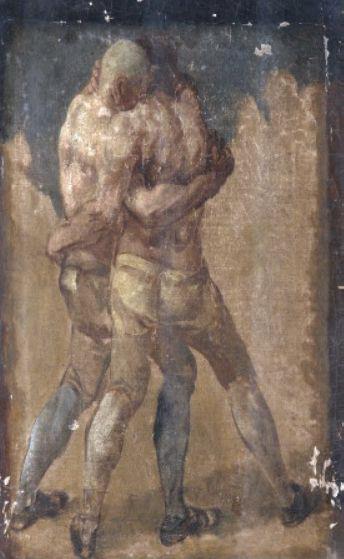
- Current status:
The London Catch-hold never found support of the managers and directors of competitions (“bosses”) who were running the pro wrestling (Cornish/Devon, Cumberland/Westmorland and, Lancashire styles) and the amateur wrestling (in case with Cumbrian Back-Hold) rings in the country. That is why in the mid 1870s popularity of Catch-Hold dropped and at the annual gatherings of Amateur Athletic Club of London at Lillie Bridge it was even replaced with Loose Wrestling or Catch-as-catch-can (German Gymnastic Society version, aka the German Ringen). In 1880, 1881 and 1882 under the patronage of Sir John Astley at Lillie Bridge was held the tournament called “The Astley Belt”. That title will remain the most unique pro wrestling championship in English history and the most prominent gathering of English pro wrestlers of all times, it was that title and that sterling silver belt (symbolic of the undisputed wrestling championship of England) which the most famous Back-Holder of all times George Steadman of Drybeck (winner of all 3 tourneys) cherished and was the most proud of winning. The London Catch-Hold ceased to exist by 1900s, but it still was taught by the best pound for pound Catch-Hold wrestler of England, middleweight champion John Wannop of Carlisle. Even in 1907 Wannop had "Catch-Hold Championships" at his own school in London.
- Sources of information :
This article is based on “The Story of Catch” (2019), by Ruslan C Pashayev.
- Name of sport (game): Cesta Punta or Jai Alai
- Name in native language: Cesta Punta or Jai Alai
- Place of practice (continent, state, nation):
Basque Country, Spain
- Sources of information :
Video:
https://www.youtube.com/watch?v=DRVh_fatHBs
https://www.youtube.com/watch?v=FSn5cAXx1rY

